Best places to see in Varanasi or Local sightseeing in Varanasi.
Ganga Arti on Dashaswamedh Ghat in Varanasi Get Tariff
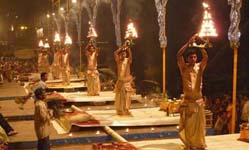 Gange aarti is the magnificent event during evening in the Varanasi that one must not miss to see it. It makes us to experience the great feelings while Gange aarti become in process. This beautiful ritual makes every moment of the evening period special and fills with the spiritual thoughts. It is performed by the brass lamps which accompanied with the mantra chant in the presence of the huge crowd. Ritual of the Gange aarti is performed by the students of the Vedas and Upanishads which is lead by the head priest of the Gangotri Seva Samiti. The whole event takes around 45 minutes.
Gange aarti is the magnificent event during evening in the Varanasi that one must not miss to see it. It makes us to experience the great feelings while Gange aarti become in process. This beautiful ritual makes every moment of the evening period special and fills with the spiritual thoughts. It is performed by the brass lamps which accompanied with the mantra chant in the presence of the huge crowd. Ritual of the Gange aarti is performed by the students of the Vedas and Upanishads which is lead by the head priest of the Gangotri Seva Samiti. The whole event takes around 45 minutes.
Gange aarti takes place at 6.45 PM in the evening after the sunset for around 45 minutes at the Dashashwamedh ghat in the Varanasi. Devotees have started to come to see the Gange aarti at least one hour before.
Kashi Vishwanath Mandir in Varanasi Get Tariff
 The history of Vishwanath Temple that is also called Golden Temple at times is full of ups and downs. The temple and city has always been on the receiving end of the invaders be it Afghans, Turks, Rohila or Marathas. The temple has been built and razed to the ground several times in the history. It was first destroyed by Bakhtiyar Khilji in the 13th century and was later rebuild. Emperor Akbar donated several acres of villages to the trust that was later cut down substantially by Aurangzeb. Aurangzeb was a fundamentalist who hated every possible religion and sects in India including Sufi and Shiite order among the Muslims. Rani Ahilyabai Holkar of Indore built the present temple that stands in Varanasi, in the year 1776. Maharaja Ranjit Singh of Lahore donated the 800-kilogram Gold-plating of the towers that gives the temple its colloquial name .
The history of Vishwanath Temple that is also called Golden Temple at times is full of ups and downs. The temple and city has always been on the receiving end of the invaders be it Afghans, Turks, Rohila or Marathas. The temple has been built and razed to the ground several times in the history. It was first destroyed by Bakhtiyar Khilji in the 13th century and was later rebuild. Emperor Akbar donated several acres of villages to the trust that was later cut down substantially by Aurangzeb. Aurangzeb was a fundamentalist who hated every possible religion and sects in India including Sufi and Shiite order among the Muslims. Rani Ahilyabai Holkar of Indore built the present temple that stands in Varanasi, in the year 1776. Maharaja Ranjit Singh of Lahore donated the 800-kilogram Gold-plating of the towers that gives the temple its colloquial name .
Aarti in Kashi Vishwanath Temple
| Mangala Aarti
| Bhog Aarti
| Sandhya Aarti
| Shringar Aarti
| Shayan Aarti
|
| 03.00-04.00 (morning) |
11.15-02.20 (day) |
07.00-08.15 (evening) |
09.00-10.15 (night) |
10.30-11.00 (night) |
Durga Temple in Varanasi Get Tariff
 The Durga temple is considered one of the most important temples in Varanasi. Built in 18th century the Durga temple is stained in Red with ochre. Though the temple might have Bangla influence spiritually, it is built exclusively on the North Indian pattern called Nagara. Multi-tired spires that decrease in diameter in horizontal pattern mark this style. Actually separate spires are clubbed together one over another to give this feel. Though this style looks less attractive than the South-Indian Gopuram pattern, it has a feel of its own. Lately, people have started calling it Monkey Temple due to the menace created by the monkeys that inhabit the campus of this Temple. At the time of Navaratri there are very mush crowd for the worship .
The Durga temple is considered one of the most important temples in Varanasi. Built in 18th century the Durga temple is stained in Red with ochre. Though the temple might have Bangla influence spiritually, it is built exclusively on the North Indian pattern called Nagara. Multi-tired spires that decrease in diameter in horizontal pattern mark this style. Actually separate spires are clubbed together one over another to give this feel. Though this style looks less attractive than the South-Indian Gopuram pattern, it has a feel of its own. Lately, people have started calling it Monkey Temple due to the menace created by the monkeys that inhabit the campus of this Temple. At the time of Navaratri there are very mush crowd for the worship .
Tulsi Manas Temple in Varanasi Get Tariff
 Tulsi Manas Temple has a very historical as well as cultural importance for not only Varanasi but also for the whole of India. This is precisely because the place is connected to an event that still rules the Indian Psyche. The famous Hindu Epic of Ramayana was composed at this very place. Goswami Tulsi Das was the man who composed Ramayana in Hindi in the form of "Ram Charit Manas". Prior to that, Ramayana was only available in Sanskrit and that is why it was out of the reach of general masses.
Tulsi Manas Temple has a very historical as well as cultural importance for not only Varanasi but also for the whole of India. This is precisely because the place is connected to an event that still rules the Indian Psyche. The famous Hindu Epic of Ramayana was composed at this very place. Goswami Tulsi Das was the man who composed Ramayana in Hindi in the form of "Ram Charit Manas". Prior to that, Ramayana was only available in Sanskrit and that is why it was out of the reach of general masses.
New Vishwanath Mandir (Birla Temple) in Varanasi Get Tariff Rate
 New Vishwanath Mandir (Birla Temple) Situated in the premises of Banaras Hindu University, a modern place of worship planned by Pandit Malviya and built by the Birlas. Open to all, irrespective of caste or creed.
New Vishwanath Mandir (Birla Temple) Situated in the premises of Banaras Hindu University, a modern place of worship planned by Pandit Malviya and built by the Birlas. Open to all, irrespective of caste or creed.
Aarti time : Aarti timings are 4 am - 4.45 am, 10.30 am - 11.45 am, 12 pm - 1 pm, 6.45 pm - 7.30 pm, 8 pm - 8.45 pm. On Shivratri, temple opens from 4 am to 12 pm midnight. On every Monday Rudrabhishek is performed from 7 am to 8 am.
Bharat Mata temple in Varanasi Get Tariff
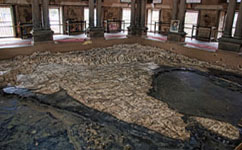 The Bharat Mata temple at Varanasi is the only temple dedicated to Mother India. It is located in the Mahatma Gandhi Kashi Vidyapeeth campus near railway station. The Bharat Mata temple was built by Babu Shiv Prasad Gupt and inaugurated by Mahatma Gandhi in 1936. The statute of Bharat Mata is built in marble and is a model of undivided India, depicting the mountains, plains and oceans. The most peculiar thing about the Bharat Mata Temple is that instead of the customary gods and goddesses, it houses a relief map of India, carved out of marble.
The Bharat Mata temple at Varanasi is the only temple dedicated to Mother India. It is located in the Mahatma Gandhi Kashi Vidyapeeth campus near railway station. The Bharat Mata temple was built by Babu Shiv Prasad Gupt and inaugurated by Mahatma Gandhi in 1936. The statute of Bharat Mata is built in marble and is a model of undivided India, depicting the mountains, plains and oceans. The most peculiar thing about the Bharat Mata Temple is that instead of the customary gods and goddesses, it houses a relief map of India, carved out of marble.
Sankat Mochan Mandir in Varanasi Get Tariff
 Sankat Mochan Mandir do not have much historical significance but is a good place to visit at least once. No body knows who established this temple. It was actually very small in its early phase. In the due course various 'Mahants' collected funds to upgrade the structure and today it boasts off a fairly large complex. The temple has every possible facility for the devotees. There is an inn too where devotees can stay overnight. The must attend religious function of this temple is the famous "Pratah Aarti" or dawn offering that takes place at 5 AM in the morning. The "Sandhya Aarti" or the evening offering is performed to Lord Sankat Mochan at around 8:30 in the night. "The Rathri Aarti" is performed at around 10 PM after which the gates are closed.
Sankat Mochan Mandir do not have much historical significance but is a good place to visit at least once. No body knows who established this temple. It was actually very small in its early phase. In the due course various 'Mahants' collected funds to upgrade the structure and today it boasts off a fairly large complex. The temple has every possible facility for the devotees. There is an inn too where devotees can stay overnight. The must attend religious function of this temple is the famous "Pratah Aarti" or dawn offering that takes place at 5 AM in the morning. The "Sandhya Aarti" or the evening offering is performed to Lord Sankat Mochan at around 8:30 in the night. "The Rathri Aarti" is performed at around 10 PM after which the gates are closed.
Gyanvapi Mosque in Varanasi Get Tariff
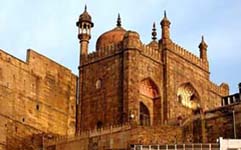 Gyanvapi Mosque This mosque was built by Mughal emperor Aurangazeb. The foundation and the rear part of the mosque are the remains of a temple. One of its minarets which dominated the skyline of the holy city, collapsed in the1948 floods
Gyanvapi Mosque This mosque was built by Mughal emperor Aurangazeb. The foundation and the rear part of the mosque are the remains of a temple. One of its minarets which dominated the skyline of the holy city, collapsed in the1948 floods
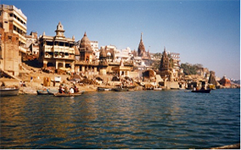 The city's life revolves around its seven km long sweep of about 100 bathing ghats that skirt the west bank of the Ganges. Most of them are used for bathing. Some are used for cremating bodies. The most sacred ghats are the Assi, Dasashwamedh Ghat, Manikarnika and Panchganga. Pilgrims who bathe in each one consecutively believe their prayers will be fulfilled. A short boat trip from Manikarnika Ghat can be an interesting introduction to the river. It is believed that cremation at Manikarnika ghat ensures a safe place in Heaven, as the cremators of this ghat are believed to have the patronage of Shiva. The furthermost upstream ghat is Assi Ghat, which marks the confluence of the Ganges and the Assi rivers. Nearby is the Tulsi Ghat, where Goswami Tulsidas lived till his death in 1623A.D. Dashashvamedh Ghat, Varanasi's liveliest bathing place was constructed by Peshwa Balaji Baji Rao. It's name indicates that Brahma sacrificed (medh) 10 (das) horses (aswa) here. It's one of the most important ghats and is conveniently central. Nearby is the grand Man Mandir Ghat (1637) and an observatory both built by Sawai Raja Jai Singh of Jaipur in 1710.
The city's life revolves around its seven km long sweep of about 100 bathing ghats that skirt the west bank of the Ganges. Most of them are used for bathing. Some are used for cremating bodies. The most sacred ghats are the Assi, Dasashwamedh Ghat, Manikarnika and Panchganga. Pilgrims who bathe in each one consecutively believe their prayers will be fulfilled. A short boat trip from Manikarnika Ghat can be an interesting introduction to the river. It is believed that cremation at Manikarnika ghat ensures a safe place in Heaven, as the cremators of this ghat are believed to have the patronage of Shiva. The furthermost upstream ghat is Assi Ghat, which marks the confluence of the Ganges and the Assi rivers. Nearby is the Tulsi Ghat, where Goswami Tulsidas lived till his death in 1623A.D. Dashashvamedh Ghat, Varanasi's liveliest bathing place was constructed by Peshwa Balaji Baji Rao. It's name indicates that Brahma sacrificed (medh) 10 (das) horses (aswa) here. It's one of the most important ghats and is conveniently central. Nearby is the grand Man Mandir Ghat (1637) and an observatory both built by Sawai Raja Jai Singh of Jaipur in 1710.
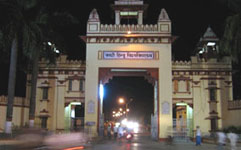 BHU is the largest residential university in Asia. It has been developed as a center for education in Indian art, music, culture and philosophy and for the study of Sanskrit. The campus also houses the Bharat Kala Bhawan that has a fine collection of miniature paintings and sculptures that dates from 1st to 15th centuries. The 5-square kilometers campus of BHU, houses as many as 55 hostels. The campus has other attractions too such as the Birla Mandir that is popularly called VT. Close by is an airstrip and a flying club. The central library named Sayajirao Gaekwad Library is also worth a visit. Apart from various manuscripts and periodicals, it houses as many as 14 lacks or 1.4 million separate volumes. There is a 1000 bedded hospital too. It is called Sir Sunder Lal Hospital. Apart from concrete buildings, the campus features open spaces, greenery and peacocks, the national bird of India, which are found roaming around almost every part of the university.
BHU is the largest residential university in Asia. It has been developed as a center for education in Indian art, music, culture and philosophy and for the study of Sanskrit. The campus also houses the Bharat Kala Bhawan that has a fine collection of miniature paintings and sculptures that dates from 1st to 15th centuries. The 5-square kilometers campus of BHU, houses as many as 55 hostels. The campus has other attractions too such as the Birla Mandir that is popularly called VT. Close by is an airstrip and a flying club. The central library named Sayajirao Gaekwad Library is also worth a visit. Apart from various manuscripts and periodicals, it houses as many as 14 lacks or 1.4 million separate volumes. There is a 1000 bedded hospital too. It is called Sir Sunder Lal Hospital. Apart from concrete buildings, the campus features open spaces, greenery and peacocks, the national bird of India, which are found roaming around almost every part of the university.
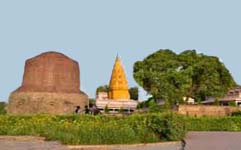 10 km. from Varanasi is the site where Lord Buddha preached his first sermon "Maha- Dharma-Chakra Pravartan" (in Buddhist terminology, 'turned the wheel of the law') after his enlightenment. Sarnath is one of the richest in Buddhist antiquities ranging in date from the times of Ashoka downto the 12th century A.D Ashoka built here the Dharmarajika Stupa and near it erected a pillar surmounted by the magnificent capital of four adorsed Lions, which today forms the national emblem of India.Among other structures at Sarnath are the ruins of the brick temple representing the Mula- Gandha Kuti, ruins of stupas and monasteries. Among the more imposing ones is the Dhamekh Stupa, adorned with delicate floral carvings in the lower part, the Chaukhandi Stupa and Mahabodhi Society's Mulgandha Kuti Vihar Temple. Sarnath has also yielded an extremely rich collection of Buddhist sculptures comprising of numerous Buddha and Bodhisatva images which can be seen at Archaeological Museum, Sarnath.
10 km. from Varanasi is the site where Lord Buddha preached his first sermon "Maha- Dharma-Chakra Pravartan" (in Buddhist terminology, 'turned the wheel of the law') after his enlightenment. Sarnath is one of the richest in Buddhist antiquities ranging in date from the times of Ashoka downto the 12th century A.D Ashoka built here the Dharmarajika Stupa and near it erected a pillar surmounted by the magnificent capital of four adorsed Lions, which today forms the national emblem of India.Among other structures at Sarnath are the ruins of the brick temple representing the Mula- Gandha Kuti, ruins of stupas and monasteries. Among the more imposing ones is the Dhamekh Stupa, adorned with delicate floral carvings in the lower part, the Chaukhandi Stupa and Mahabodhi Society's Mulgandha Kuti Vihar Temple. Sarnath has also yielded an extremely rich collection of Buddhist sculptures comprising of numerous Buddha and Bodhisatva images which can be seen at Archaeological Museum, Sarnath.
Bharat Kala Bhavan Museum in Varanasi Get Tariff
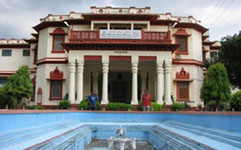 Bharat Kala Bhavan is an art and architecture museum situated inside the BHU campus. Here, one can find a large number ofBuddhist and Hindu sculptures, paintings and other materials of archaeological relevance.This Bhavan was founded in 1920 A.D. In its main hall, there is a figure of a man standing on one leg, holding one hand on his hip and lifting a mass of stone above his head with the other hand. It is believed that this figure is of Lord Krishna lifting Mount Govardhana. Most of the images in this Bhavan ascertain the presence of Krishna cult in Kashi during the 15th and 16th century.
Bharat Kala Bhavan is an art and architecture museum situated inside the BHU campus. Here, one can find a large number ofBuddhist and Hindu sculptures, paintings and other materials of archaeological relevance.This Bhavan was founded in 1920 A.D. In its main hall, there is a figure of a man standing on one leg, holding one hand on his hip and lifting a mass of stone above his head with the other hand. It is believed that this figure is of Lord Krishna lifting Mount Govardhana. Most of the images in this Bhavan ascertain the presence of Krishna cult in Kashi during the 15th and 16th century.
Ashoka Pillar in Saranath Varanasi Get Tariff
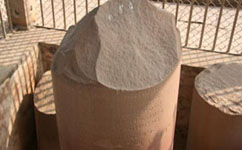 Ashoka Pillar It is at Saranath, 10km north of Varanasi. Sarnath, the place where Buddha gave his first sermon is a popular Buddhist pilgrimage centre. The Ashoka pillar stands in front of the main stupa where Ashoka sat and meditated. The Sarnath Archaeological Museum at Ashoka Marg, houses a copy of Ashoka's lion pillar and some sculptures.
Ashoka Pillar It is at Saranath, 10km north of Varanasi. Sarnath, the place where Buddha gave his first sermon is a popular Buddhist pilgrimage centre. The Ashoka pillar stands in front of the main stupa where Ashoka sat and meditated. The Sarnath Archaeological Museum at Ashoka Marg, houses a copy of Ashoka's lion pillar and some sculptures.
Manikarnika Ghat in Varanasi Get Tariff
 This is one of the more famous of the Varanasi ghats where Hindus bring their dead for cremation. There is a fire here that's been burning for the 4 centuries, it is claimed and is never allowed to die out. Burning logs from this fire is used to light the funeral pyre. It's not for everyone but there is something about the place that leaves a deep impact.
This is one of the more famous of the Varanasi ghats where Hindus bring their dead for cremation. There is a fire here that's been burning for the 4 centuries, it is claimed and is never allowed to die out. Burning logs from this fire is used to light the funeral pyre. It's not for everyone but there is something about the place that leaves a deep impact.
Buddhist Temples in Sarnath Get Tariff
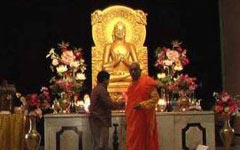 Visitors to Sarnath usually wind up their visit by going through the main stupas and the museum at Sarnath. But beyond the main excavation site in the narrow lanes are some exquisite Buddhist temples set up and run by followers from countries like Japan, Burma, Thailand, Cambodia, China etc It is a treat to visit these temples. There are amazing artifacts and ancient maps that trace the spread of Buddhism.
Click here to know more »
Visitors to Sarnath usually wind up their visit by going through the main stupas and the museum at Sarnath. But beyond the main excavation site in the narrow lanes are some exquisite Buddhist temples set up and run by followers from countries like Japan, Burma, Thailand, Cambodia, China etc It is a treat to visit these temples. There are amazing artifacts and ancient maps that trace the spread of Buddhism.
Click here to know more »
 Sukrit is a small town that lies on the Varanasi-Robertsganj national highway around 55 kms away from the city. The place is extremely rich in natural beauty. Small tribal villages dot the landscape around a meandering river and the way of life has remained more or less untouched by the curse of civilization. On the way is Lakhania Dari which is home to some ancient rock painting, caves and a beautiful waterfall. A Place only for those who are avid nature lovers and hate the crowds
Sukrit is a small town that lies on the Varanasi-Robertsganj national highway around 55 kms away from the city. The place is extremely rich in natural beauty. Small tribal villages dot the landscape around a meandering river and the way of life has remained more or less untouched by the curse of civilization. On the way is Lakhania Dari which is home to some ancient rock painting, caves and a beautiful waterfall. A Place only for those who are avid nature lovers and hate the crowds